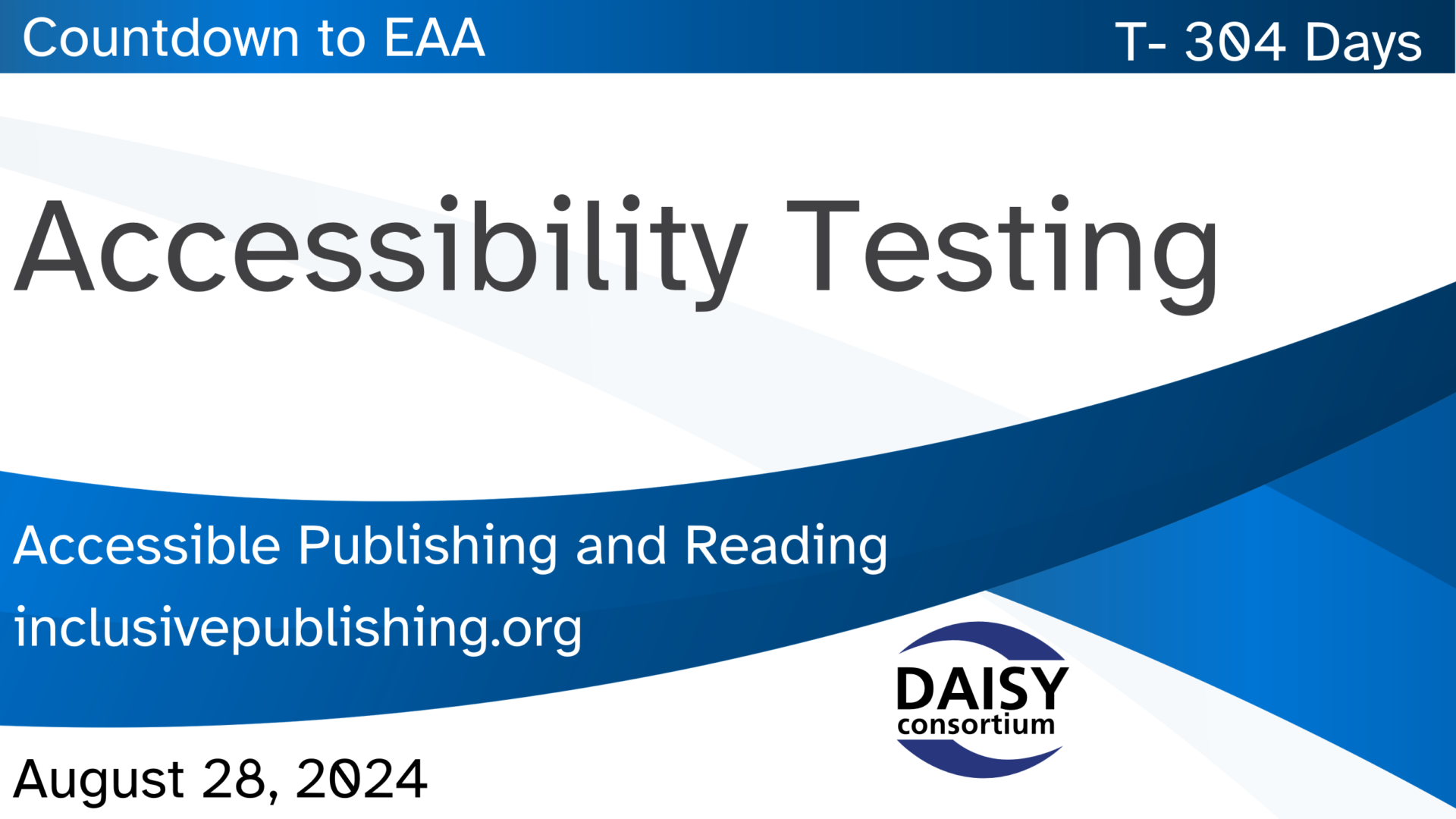Accessibility Testing T-304 (W)

In our series of EAA monthly webinars August 28th saw a session that explored the diverse range of tests and assessments, both automated and manual, that can be performed to help refine the user experience and ultimately ensure a content journey that supports accessibility.
This page contains:
Full Video of the Webinar
Speakers
- Richard Orme, The DAISY Consortium—host and chair
- Magnus Nyland, Society for Swedish Literature in Finland (SLS)
- Ted Gies, Elsevier
- Prashant Verma, The DAISY Consortium
- Alejandro Moledo, European Disability Forum
- Alisa Zarkova, Lithuanian Audio Sensory Library
Session Overview
Magnus Nyland, Content Testing
Magnus talked to us about accessibility testing for content creators and the various tools and methods available within the publishing workflow where he has witnessed a lot of progress in recent years. For example, alt text was, at one time, an afterthought whereas now it is fully part of the process. Using mainstream tools such as Ace by DAISY, the Digital Publishing Knowledge Base and DAISY SMART, Magnus talked us through the content creation workflow that SLS have in place using 3rd party vendors for some of the work and developing their own bespoke testing methods. Ace is used numerous times throughout the workflow and manual testing of content on various ereaders provides vital feedback as well as user testing from readers with lived experience.
Magnus finished with some words of wisdom
- Start small and go through the testing process one step at a time
- Take advantage of the free DAISY tools that are available
- Listen carefully to feedback from all sources
Ted Gies, Web Accessibility Testing
Ted gave us an overview of some of the techniques and tools that are available to enable accessibility testing of web pages. Web accessibility testing is very important for the EAA as the directive requires ebooks and sites to perceivable, operable, understandable and robust (aka POUR) and this includes publishing retail sites, distributors sites and all other sites involved in the publishing supply chain.
To help get started with this, Ted gave us an indication of the web accessibility testing tool and approaches that he recommends for:
- automated scanner tools
- manual testing
- user testing
- assistive technology testing
- guide based testing
- advanced tooling
Prashant Verma, Reading Systems
Prashant encouraged us to think about what makes a reading system accessible. By ensuring that the reading app interface is accessible and that it supports the accessibility features within the EPUB content, we are on the right path to providing an accessible reading experience for the user.
The user interface is accessible when: it allows interaction with different input methods, it supports assistive technology as well as colour contrast and text resizing requirements.
The type of EPUB features that should be supported are: table of contents and print page navigation, alt text for all images, visual adjustments and read aloud.
The reading system can be tested for their support of best practices and recognised standards via epubtest.org. The evaluation are conducted by accessibility experts and assistive technology users (a variety of assistive tech is used). The testing framework covers fundamental and advanced accessibility tests with results for each area given alongside notes to assist with improvements. Details of the results can be found on the main epubtest website and a higher level overview is also published in inclusive publishing which is a very useful roundup for developers and users alike.
Industry Perspectives
Our remaining 2 speakers spoke about their enthusiasm for the EAA and what still needs to be done. Alejandro Moledo noted that one of the unique aspects of the EAA is that it will mean that accessibility will be considered from the outset. Full accessibility can’t be achieved overnight but he hopes that everyone is taking the time to prepare by collaborating with the disability community. Alisa Zarkova looks forward to enhanced accessibility for all publications and an increased number of born accessible publications. The high level of engagement in inclusive publishing projects is an exciting indicator of how hard everyone is working.
Related Resources
Resources mentioned:
- Ace by DAISY
- Ace SMART
- Accessible Publishing Knowledge Base
- EPUBTest
- Thorium Reader
- Colibrio Reader
- Calibre Reader
- Oxygen XML
- Benetech Global Certified Accessible
- DHS Trusted Tester Conformance Test Process
- DEQUE Axe
- WebAIM WAVE
- DSS ANDI
- Microsoft Accessibility Insights
- W3C Web Content Accessibility Guidelines
- Deque University
- Jaws screen reader
- NVDA screen reader
Guest presenter links:
- Society for Swedish Literature in Finland (SLS)
- Ted Gies | LinkedIn
- Elsevier
- Prashant Verma | LinkedIn
- Alejandro Moledo | LinkedIn
- European Disability Forum
- Alisa Zarkova | LinkedIn
- Lithuanian Audio Sensory Library

